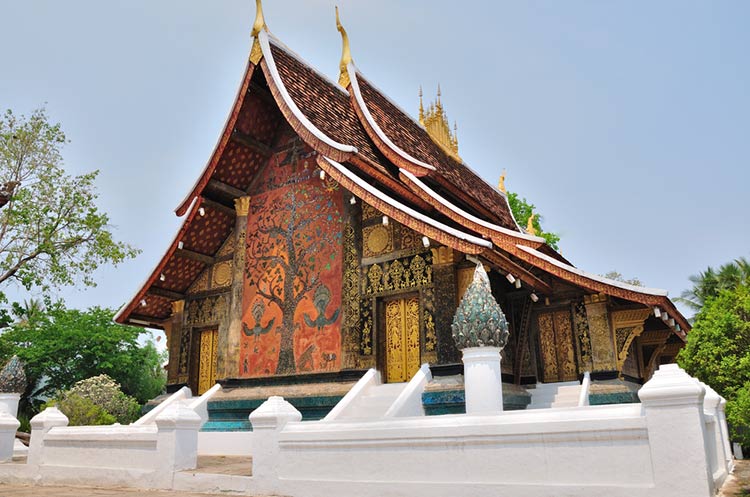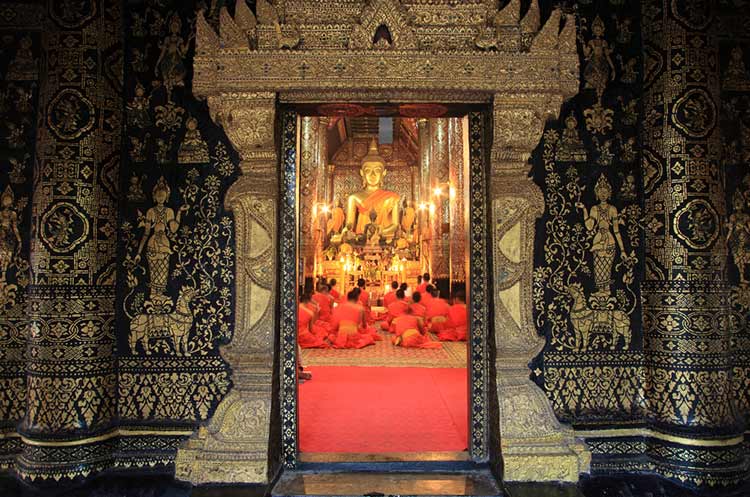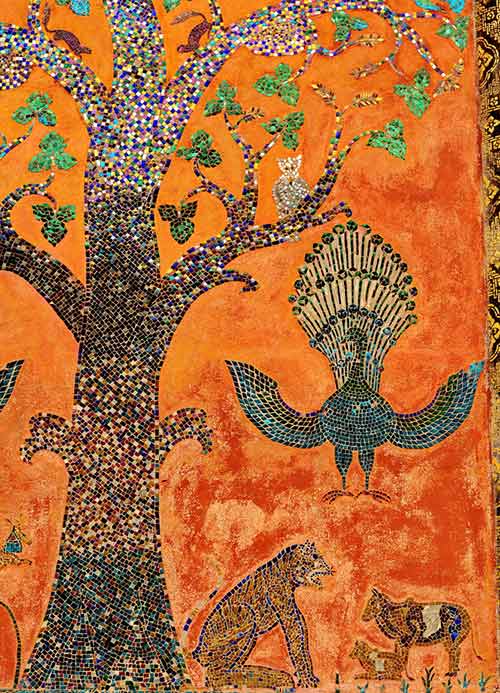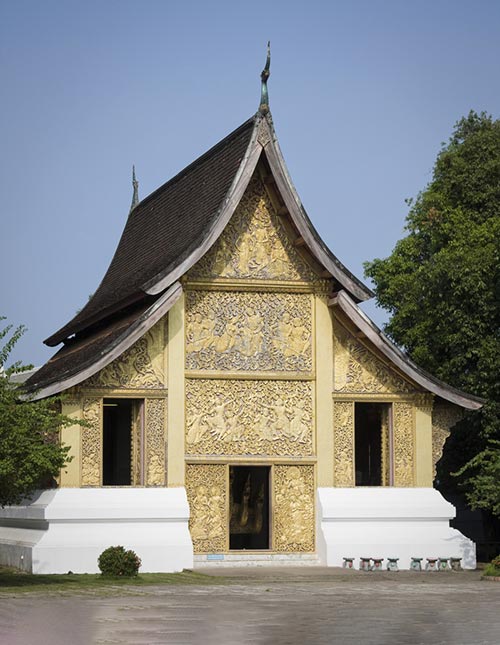
Wat Xieng Thong
One of Laos’ most beautiful and richly decorated temples
Luang Prabang
The Wat Xieng Thong located at the tip of the Luang Prabang peninsula is one of Laos most beautiful and richly decorated temples.
The Wat is a Royal temple built by King Setthathirath in 1559 on the banks of the Mekong river. It is one of the few temples that was not destroyed during the Black Flag Army invasion of 1887.
Road and river entry
There are two entrances to the temple. The road entry is through an elaborate gateway topped with a circular stupa. The Mekong river entry used to be the main entry point in previous centuries. It was the entry that the King used when he arrived by boat from the Royal Palace. A long, broad stairway from the Mekong river leads to the temple; near the top are two large white lions guarding the grounds.
The sim
The Wat Xieng Thong’s most impressive building is the sim, the temple’s congregation hall. Both the sim’s exterior and interior are very extensively decorated with intricate gold stencilling on black lacquer.
Luang Prabang style sweeping roof
The impressive structure is built in the Luang Prabang style, its sweeping roof extending almost to the ground. The roof consists of a large, 3 tiered central section flanked by several 2 tiered sections. On top of the central part is a gilded “Dok so faa”, an ornamental element consisting of 17 miniature stupas covered by 7 tiered parasols.

Interior of the sim
Decorated exterior
The gable is decorated with carved and gilded floral motifs and Dhamma wheels on a red lacquer background. The front portico’s roof is supported by four black and gold stencilled columns. The façade under the portico is black lacquer with gold stencilling of deities, mythological animals, scenes from the Jataka tales and floral motifs. The temple’s exterior walls are decorated with gold stencilled deities, Apsaras and kinnaree.
Mosaic of the tree of life
The sim’s back wall contains a colorful mosaic of the tree of life on a red background, made in the 1960’s. In the top of the picture is a standing Buddha, at the bottom of the picture are a man walking and several animals including a tiger and two peacocks. On either side of the mosaic is an intricately carved, gilded entrance door.
Gold on black lacquer interior
The sim’s interior is as impressive as its exterior. Large stencilled teak wood pillars support the roof; its walls are stencilled in gold on black lacquer with floral motifs, animals, scenes of daily life and Jataka tales. One of the walls contains a depiction of the Heavens with the Buddha and several deities, the Earth with people and trees, and the Hells with pictures of people receiving punishments for their sins.
Principal Buddha image
Seated on an elaborate pedestal is the principal Buddha image in the Bhumisparsha mudra, surrounded by many smaller images.
Chapel of the standing Buddha
Next to the sim is the Chapel of the Standing Buddha. Its pediment is adorned with colorful glass mosaics of flower motifs and two kinnaree, a mythological creature half human, half bird. At the center of the roof is a small pagoda; the roofs ends are adorned with Chofahs, finials depicting the mythological Naga serpent believed to protect Buddhism.
The carved and gilded doors give access to the small chapel; its interior walls are red covered with gold stencilling. At the back wall of the chapel is a large standing Buddha image. The bronze, gilded image is in the Abhaya mudra, expressing fearlessness.

Chapelle rouge
Behind the Chapel of the Standing Buddha is the Chapelle Rouge or red chapel. Its exterior walls contain colorful mosaics on a pink background. The upper part of the mosaics show the Heavens, the lower part the Earth with houses and people engaging in daily activities. They were created in the 1950’s to commemorate the Buddha reaching Nirvana 2,500 years before. Inside the chapel is a bronze reclining Buddha image. The inscription on it states that is was made in 1569 by order of King Setthathirat.
Chariot Hall
The Chariot Hall or Royal Funerary Chariot Hall is a much more recent structure; it was completed in 1962. It contains the funeral carriage of King Sisavang Vong who died in 1959. Tha hall built in classic style has a two tiered roof adorned with Naga finials. Very attractive carved and gilded teak wood panels of the façade depict flower motifs and scenes from the Phra Lak Phra Lam, the Laos version of the Indian epic Ramayana.
Its interior walls are decorated with glass mosaics and gold stencilling on red lacquer. Lined along the walls are a number of early 19th century Buddha images. The hall contains King Sisavang Vong’s gilded, carved wooden funeral carriage, decorated with large Naga snakes at the front. Inside the carriage are three very elaborate urns that used to contain the ashes of the King, his father and his mother.

Ho Trai
Behind the sim is the Ho Trai, the library where the Tripitaka, the Buddhist scriptures are kept. The Ho Trai is a small, elaborately decorated structure set on a stone base. It has a double roof, with stylized Naga finials at its ends. Its exterior walls are in a similar style as those of the Chapelle rouge. Colorful glass mosaics on a pink background depict scenes of daily Luang Prabang life. The structure also contains a number of gilded Buddha images.
Drum tower
The drum tower or drum chapel was built in the 1960’s. It is used to call the monks to prayers. In most temples the drum tower looks like an actual tower; the Wat Xieng Thong’s drum tower looks more like a small, open chapel containing a large drum. The classical style structure has a beautiful carved, gilded gable in much the same style and colors as the sim.
Other structures
Other structures on the temple grounds include several stupas, a pavilion with a seated Buddha, the kuti or monks living quarters, a boat shelter and a Bodhi tree.
Location
The temple is located at the end of the Luang Prabang peninsula between Khem Khong road and Sakkaline road.
How to get to the Wat Xieng Thong
Much of the old town can be reached on foot. A tuk tuk or jumbo will cost between 10,000 and 15,000 Kip depending on distance.
Opening hours
The temple opens daily from 8 am until 5 pm.
The Wat Xieng Thong is an active temple with monks living and praying here; please dress respectfully, which means no bare shoulders, no shorts or short skirts. If needed, a traditional sarong can be rented to cover up. Please remove shoes before entering one of the temple buildings.
Entrance fee
Entrance fee is 20,000 Kip per person.
Temples in Luang Prabang
Luang Prabang Temples
Other attractions Luang Prabang